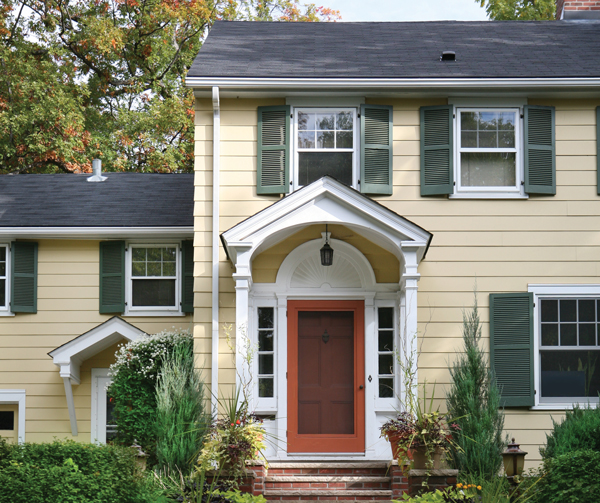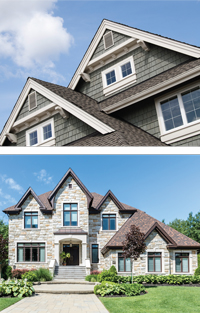Exterior Upgrade | What to Know When Selecting Siding

Coming home after a long day should bring a smile to your face. But if your home’s curb appeal has faded, these daily homecomings are a little less joyful. Siding is an aspect of your home you may not pay much attention to until it’s looking less than pristine. Whether it’s dented from teaching the kids to play baseball, damaged from storm debris, or blistered or faded from sun damage, siding needs an upgrade every now and then.
Replacing outdated siding may seem daunting, but this change will not only make your home look better, it can provide increased insulation and energy efficiency, and protect your home from structural and interior damage.
The first step to a siding makeover is determining which style of siding you prefer. There are many types of siding such as vinyl, fiber cement, brick, metal—even stone, stucco, and polymer. While each has its strengths and considerations, our housing market and weather conditions tend to favor vinyl siding, fiber cement (a rugged wood alternative), and brick siding.
Vinyl siding
Whether you picture a rustic ranch-style home, or a brightly colored, energy-efficient cottage, vinyl siding offers a classic look without the added maintenance. This material is the clear leader in the siding market, covering more than 30 percent of U.S. home exteriors. The pros to vinyl are its ability to stand tall against wind and rain, a wide array of color and texture choices, durability (generally 30- to 40-year warranties), heightened insulation, and cost-effectiveness.
Though horizontal vinyl panels are a classic choice, there are other options to consider. Vertical panels, board and batten, shakes (where the vinyl mimics the look of wood), and scalloped siding can stand alone to create a uniform look or be mixed and matched to offer different textures and increase your home’s custom appeal. For instance, siding in a cedar shake style can be paired with board and batten panels to create an eye-catching look. Horizontal siding combined with vinyl cedar shakes and scalloped vinyl can create the look of a quaint gingerbread house. And if your gingerbread lookalike gets dirty, all it needs is a quick wash with a hose for its former glory to be restored.
Fiber cement
Wood siding is often viewed as traditional, rustic, and warm. But with this option comes the threat of termites, weather-warping, high installation costs, and the demands of regular maintenance. Fiber cement—composed of wood fibers, sand, and cement—is molded and embossed in a way that offers the look of wood without the worry.
This siding choice (also known as HardiePlank® after its creator, John Hardie), is stronger than wood, more durable than vinyl, moisture and UV resistant, no match for pesky termites, mold and rot resistant, and comes in many finishes. These benefits come at a cost two or three times higher than vinyl, but fiber cement offers a longer life span than wood, a warranty of at least 30 years, and a chip-resistant guarantee of at least 15 years. Given all the benefits, it’s no surprise that this option is growing in popularity!
Brick
Throughout the centuries, bricks have been used to fashion homes, workspaces, and places of worship in nearly any architectural design. This longstanding form of siding is made from clay and shale, then fired in a kiln at approximately 2,000 degrees Fahrenheit. It’s loved for its traditional charm, not to mention its pleasing aesthetic and impressive lifespan. Historic buildings, such as St. Luke’s Church in Smithfield, Virginia, are proudly wearing their traditional brick outfits dating back to the 1600s! They are also are highly fire resistant, don’t need to be repainted or finished, are termite proof, and only look better with age.
A downside to brick which cannot be ignored is the high cost of installation. Brick siding is one of the most expensive choices, but requires the least amount of upkeep, and can often garner lower home insurance rates because of its impeccable durability.
 Hiring a contractor
Hiring a contractor
The next step in your home’s new look—finding the best contractor to install your new siding—closely hinges upon what material you choose. Different areas of the world have a plethora of contractors who specialize in installing the siding best suited to that region. For instance, stucco, a durable wall coating heavily influenced by Spanish and Mexican architecture, has less installation help available in our area than brick masonry.
The contractor you choose should be properly licensed, have many years of experience with positive reviews, use only highly trusted subcontractors, have siding warranty coverage, and meticulously clean up after the job is complete. They should also carefully consider the ventilation needs of your home, as well as install a waterproof wrap under siding to prevent leaks.
When your contractor arrives on site, your old siding may or may not need to be removed. Removal is based on current condition, new siding type, and personal preference. If the old siding isn’t warped or damaged enough to be visible under the new siding, it may be kept for an added layer of protection. Next, insulation may be added under the new siding to further increase “R-value” (the capacity of a material to resist heat flow), waterproof wrap installed, and proper ventilation created. Then, the siding is put on your home. Final touches such as soffits, the fascia board, any box ends, and bargeboards must also not be forgotten, as these additions are essential to properly trim the exterior.
Upgrading your home’s siding promises many benefits, from curb appeal to energy efficiency to preventing structural damage. And, the many options now available mean you can transform your home’s exterior into the gingerbread house, vintage farmhouse, or breezy cottage of your dreams.
brick, contractor, exterior siding, fiber cement, improve, metal, polymer, siding, siding installation, stone, stucco






